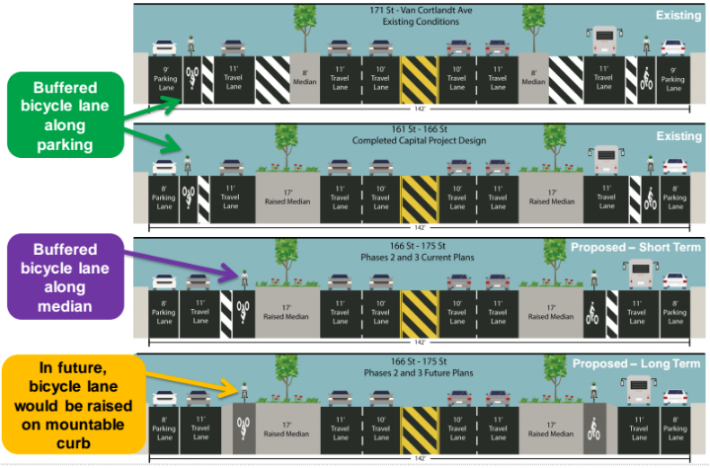
In February, DOT said it would upgrade the bike lanes on the Grand Concourse service roads, and last night the agency showed what it has in mind for the mile-long stretch between 166th Street and 175th Street [PDF].
The first step will be to shift the bike lanes to run along the median instead of the parking lane, reducing conflicts between cyclists and drivers accessing the curb. Later, the bike lanes will be rebuilt at sidewalk grade to provide physical separation from motor vehicles. The timeline for implementing the changes remains uncertain.
The city is currently reconstructing the Grand Concourse from the sewers on up between 161st Street and Fordham Road, a four-phase capital project. Last night's presentation was an update from DOT on the second phase (covering 166th to 171st) and third phase (171st to 175th) to Bronx Community Board 4's municipal services committee.
(Phase 1, which runs from 161st Street to 166th Street, was completed back in 2008 without any bike lane upgrades. A separate pedestrian safety project between 138th Street and 158th Street, where there aren't service roads, doesn't include any bike lanes, though DOT indicated bikeways could be incorporated into a future capital project for that segment.)
More people are killed while walking on the Grand Concourse than on any other street in the Bronx, according to the Tri-State Transportation Campaign, with 10 pedestrian fatalities along the four-mile street between 2012 and 2014. After Mayor de Blasio launched his Vision Zero initiative, his administration named the Grand Concourse one of four Vision Zero "Great Streets" that are supposed to bake safer designs into reconstruction projects.
Transportation Alternatives' "Complete the Concourse" campaign has gathered nearly 2,500 signatures calling for protected bike lanes, curb extensions, and bus lanes on the Grand Concourse. Bronx Borough President Ruben Diaz Jr. and local council members Ritchie Torres, Andy Cohen, and Rafael Salamanca Jr. are supporters.
The design concept presented last night does not include bus lanes or alter the wide central roadway of the Concourse. It's unclear if, in addition to the bike lane upgrades, the redesign will also close or square off the slip lanes between the central roadway and the service roads, as DOT did with its redesign of Queens Boulevard.
Above 161st Street, the Grand Concourse currently has buffered bike lanes on the service roads, but they are frequently obstructed by double-parked cars. Cyclists must also contend with buses merging into the curb lane.
TA Bronx Organizer Erwin Figueroa attended last night's meeting. He said that median-aligned bike lanes will be an important step forward, but until physical separation from car traffic is provided, illegal parking will still cause problems for cyclists -- especially on weekends when churchgoers show little regard for the street's parking regulations.
"By not having any protection, [those parking violations] will probably continue," Figueroa said. When he asked DOT reps last night why a barrier won't be included from the outset, Figueroa was told it would interfere with street sweeping by the median. DOT says it will eventually raise the bike lane to sidewalk elevation, creating physical separation, but has not specified a timetable.
The committee endorsed the new design for Phase 2 of the Grand Concourse, which will get a full CB 4 vote on June 28. DOT said it is still working to finalize the design for Phase 3, which it will present again later.
In the fall, DOT will hold a public workshop about Phase 4, covering 175th Street to Fordham Road.





